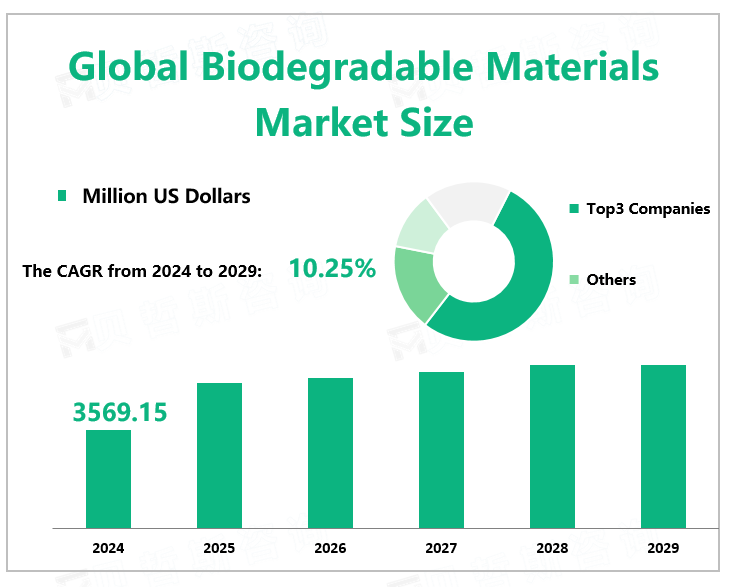Global Biodegradable Materials Market Overview
According to Global Market Monitor, the global biodegradable materials market size will reach $3569.15 million in 2024 with a CAGR of 10.25% from 2024 to 2029.
Biodegradable materials decompose naturally through temperature, sunlight, or the processes of bacteria, fungi, molds, and other living organisms in a process known as composting. Food waste, grass cuttings, tree leaves, and branches are commonly composted products.
Market News
With the growing demand for biodegradable materials, market players are taking various strategic initiatives.
In May 2024, South Korean chemicals company SKC announced plans to build the world's largest biodegradable plastics plant in Haiphong, Vietnam, with an annual capacity of 70,000 tons of polybutylene adipate terephthalate (PBAT). The flexible bioplastic, used in packaging and more, will be enhanced with nanocellulose from trees for a wider range of applications, including personal hygiene products.
In March 2024, Beyond Plastic announced a partnership with CJ Biomaterials to produce biodegradable plastic-based bottle caps. The caps are made of polyhydroxyalkanoate (PHA), a biopolymer derived from natural sources that enhances the functional properties of conventional plastics while providing environmental benefits.

Biodegradable Materials Application Fields
Packaging is one of the fastest-growing industries in the world and a major application area for bio-explanatory materials. About 40.0% of plastic packaging is used only once and then discarded. In addition, about 500 million plastic bags are used worldwide every year. However, the increasing use of plastics poses a serious threat to the environment. With the advent of digital media, consumers and manufacturers have shifted their preferences towards recyclable and environmentally friendly materials. Europe has developed the Packaging and Packaging Waste Directive, which has two main objectives: to help prevent trade barriers and reduce the environmental impact of packaging waste. Similarly, the U.S. Food and Drug Administration (FDA) has imposed strict regulations on recycling plastic materials for food contact, all of which are expected to provide growth opportunities for biodegradable plastics.
Food packaging, disposable tableware (including cups, plates, cutlery, etc.) and plastic bags are the largest end-user market for biodegradable goods and the main growth engine. Food safety is an important requirement for food production and packaging. The booming retail industry and increased consumer consumption of packaged food, rapid changes in lifestyles and food preferences, along with population growth and economic growth in various regions, will increase packaging solutions. The needs of the program and these areas will benefit from the “plastic limit order” or “ban on plastics” of government departments in various countries and regions.
|
By Type |
Natural Macromolecule Cellulose |
|
Synthetic Materials |
|
|
Others |
|
|
The synthetic materials segment accounts for the largest share. |
|
|
By Application |
Packaging |
|
Agriculture |
|
|
Medical |
|
|
Chemical Industry |
|
|
The packaging segment occupies the biggest share. |
We provide more professional and intelligent market reports to complement your business decisions.